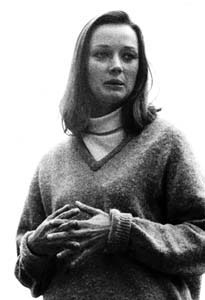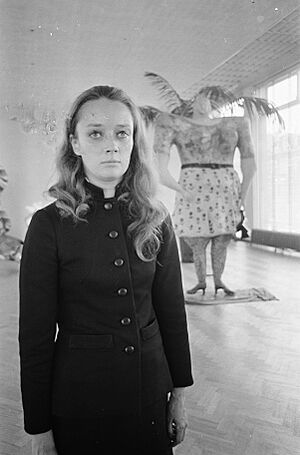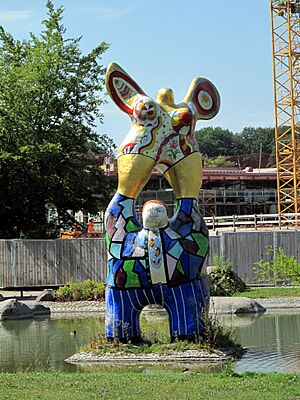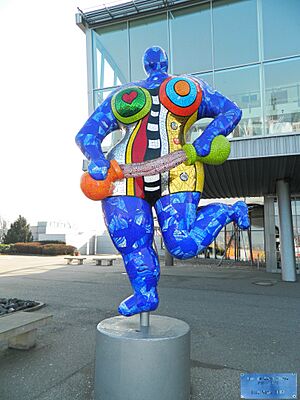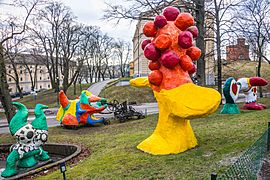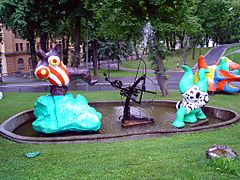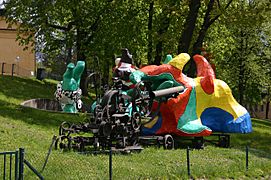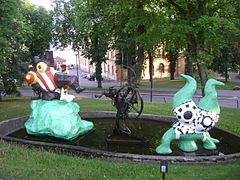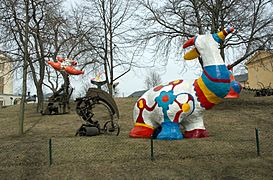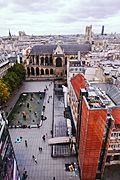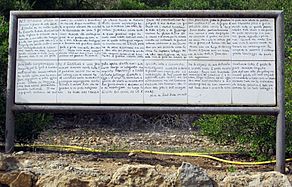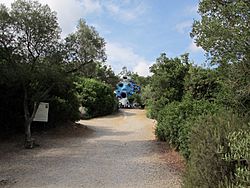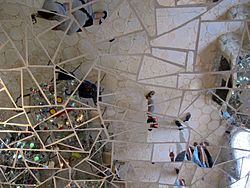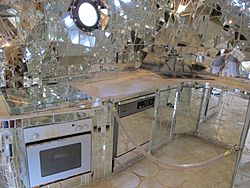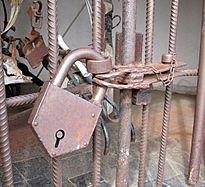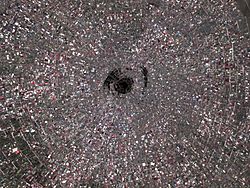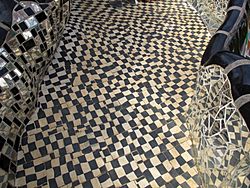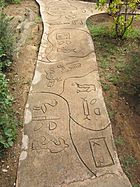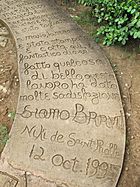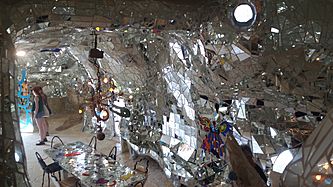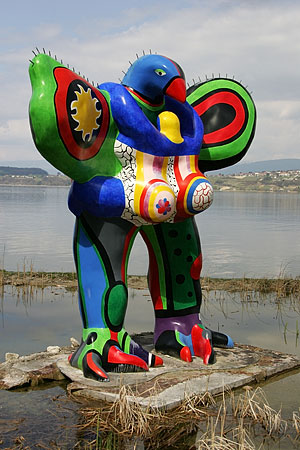Niki de Saint Phalle facts for kids
Quick facts for kids
Niki de Saint Phalle
|
|
|---|---|
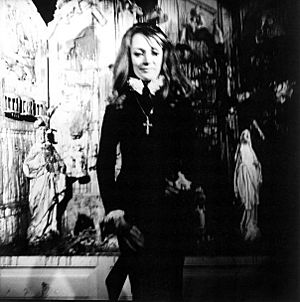
1970 portrait by Lothar Wolleh
|
|
| Born |
Catherine Marie-Agnès Fal de Saint Phalle
29 October 1930 Neuilly-sur-Seine, Hauts-de-Seine, France
|
| Died | 21 May 2002 (aged 71) La Jolla, California, United States
|
| Nationality | French, American, Swiss |
| Education | Self-taught in art |
| Known for | Sculpture, painting, filmmaking |
|
Notable work
|
Nanas Tarot Garden |
| Style | Nouveau réalisme, Feminist art |
| Spouse(s) |
|
| Awards | Prix Caran d’Ache (1994) Praemium Imperiale (2000) |
| Patron(s) | Agnelli family |
Niki de Saint Phalle (born Catherine Marie-Agnès Fal de Saint Phalle; 29 October 1930 – 21 May 2002) was a famous French-American artist. She was a sculptor, painter, and filmmaker. She also wrote colorful books with her own drawings.
Niki de Saint Phalle was one of the few women known for creating huge sculptures. She was also famous for caring about social issues and showing this in her art. She had a challenging childhood and her schooling was often interrupted.
She started making art in a free, experimental way after getting married and having two children. She first became known for angry, strong artworks that were "shot" with firearms. These artworks later changed into her famous Nanas. These are large, happy, colorful sculptures of animals, monsters, and female figures.
Her biggest project was the Tarot Garden. This is a huge sculpture garden filled with many artworks, some as big as houses. Niki de Saint Phalle taught herself art. She worked with many other artists, writers, and musicians. Her books and letters were written in a childlike style. Yet, she used them to talk about important global problems. She often questioned things that were ignored.
She worked closely with Swiss artist Jean Tinguely for many years. He later became her second husband. Niki de Saint Phalle kept creating art until the end of her life. She faced health problems from the materials she used in her early artworks.
One art expert said that Niki de Saint Phalle was "one of the most important female and feminist artists of the 20th century." She was also one of the few women to be recognized in the art world during her lifetime.
Contents
Early Life and School Years (1930–1948)
Niki de Saint Phalle was born on October 29, 1930. This was in Neuilly-sur-Seine, near Paris, France. Her father was a French banker, and her mother was American. Niki was the second of five children.
When she was very young, her parents moved to the United States. She stayed with her grandparents in France for a few years. Around 1933, she joined her parents in Greenwich, Connecticut. Her father worked for the family bank there. In 1937, her family moved to New York City. By this time, she was known as "Niki," the name she used from then on.
Niki grew up in a strict family. She often rebelled against the rules. She spent most of her childhood in New York City. She visited France often and spoke both French and English fluently. She went to several schools but was often expelled. At one school, she was dismissed for painting on statues. She later said this school helped her become a feminist. She graduated from Oldfields School in 1947.
In her late teens, Niki became a fashion model. She appeared on the cover of Life magazine in 1949. Three years later, she was on the cover of French Vogue. She also appeared in other fashion magazines.
Starting a Family and Art (1949–1960)

At 18, Niki de Saint Phalle married Harry Mathews. They had met when they were children. They first had a civil wedding in New York City in 1949. Later, they had a religious ceremony.
Niki's family accepted the marriage. But Harry's family did not like her background. They stopped supporting them financially. Niki and Harry moved to Cambridge, Massachusetts. Harry studied music at Harvard University. Niki started painting with oils and watercolors. She also wanted to be an actress.
Their first child, Laura, was born in 1951. In 1952, the family moved to Paris. Harry continued his music studies. Niki felt that her family's traditional values meant wives should stay at home. She wanted to escape this lifestyle.
For about ten years, the family traveled around France and Europe. They lived a free, artistic life. In 1954, Niki met American-French painter Hugh Weiss in Paris. He became her friend and art teacher. He encouraged her to keep painting in her unique style.
In September 1954, the family moved to Deià, Spain. Her son Philip was born there in May 1955. While in Spain, Niki read books by Proust. She also visited Madrid and Barcelona. She was deeply impressed by the work of architect Antoni Gaudí. Gaudí's art showed her new ways to use unusual materials in sculpture. She loved his "Park Güell" and dreamed of creating her own garden one day.
Niki continued to paint. Her first art show was in Switzerland in 1956. She showed her simple, self-taught oil paintings. In 1956, she met Swiss artist Jean Tinguely. She tried her first large sculpture, and Tinguely helped her make a metal frame. She covered it with plaster and paint.
In 1959, Niki saw artworks by many modern artists. This made her rethink her own art. She stopped using oil paint. She started making assemblages from everyday objects. By this time, she decided to focus completely on art.
In 1960, Niki and Harry separated. Harry moved to another apartment with their two children. Niki visited them often. She soon moved in with Jean Tinguely. They lived together and worked on art projects for over ten years. They married in 1971. They separated two years later but remained friends. They continued to work together until Tinguely's death in 1991.
In 1960, Tinguely introduced Niki to Pontus Hultén. He was the director of the Moderna Museet in Stockholm, Sweden. He invited her to important exhibitions. He also bought her artworks for the museum. He later became the first director of the Centre Georges Pompidou in Paris. He helped her art become more widely known.
Tirs (1961–1963)
In the early 1960s, Niki de Saint Phalle created a series of works called Tirs ("Shootings" or "Shots"). She started with "target pictures." These had bullseye targets in her painted collages. She invited people to throw darts at dartboards in her sculptures.
Soon, she began to embed objects like knives, scissors, and doll arms into plaster. She also put bags of colorful paints and spray paint cans inside. Then, she would shoot the artwork with a pistol or rifle. This made the liquids "bleed" or spray out.
Her first public shooting event was in February 1961 in Paris. Many artists attended. Her early art events took place in a back alley in Paris. It was a place where many experimental artists had studios.
Pierre Restany, who started the Nouveau réalisme ("New Realist") art movement, asked Niki to join his group. She became the only female member. Her use of violence in art caught the media's attention. This made her a leading artist in the 1960s. The Tirs combined performance, sculpture, and painting.
Niki presented these "shootings" in museums and galleries. She invited other artists to join her in public "happenings." She also organized indoor events where visitors could shoot her artworks. She met many new artists at these events.
In June 1961, Niki de Saint Phalle and Jean Tinguely worked with other artists. They performed in a concert called Variations II. It was arranged by composer John Cage in Paris. The artists created their works on stage while the audience watched.
In August 1961, Marcel Duchamp introduced Niki and Tinguely to Salvador Dalí. Dalí asked them to create an exploding bull with fireworks. This was a tribute to Dalí. It exploded in front of an audience after a bullfight in Spain.
In 1962, she had her first solo show in New York City. It included a shooting gallery where visitors could shoot one of her Tirs installations. This started her long working relationship with gallery owner Alexander Iolas.
A special outdoor shooting event in Malibu, California in 1962 had Hollywood stars like Jane Fonda. Artists like John Cage also attended. Niki was always dressed in a stylish white pantsuit for these performances.
By 1963, she took her Tirs series to galleries in New York City and Los Angeles. She invited the public to participate. In Los Angeles, she shot a large King Kong sculpture. It had faces of politicians and cartoon characters. This work marked her move to a new series of fantastic monsters and female figures. Snakes, birds, and dragons became common symbols in her art.
In 1963, Niki and Tinguely bought an old hotel near Paris. They turned it into art studios.
Nanas (1964–1973)
Niki de Saint Phalle then explored the different roles of women. This became her most famous series of sculptures. She started making life-sized dolls of women, monsters, and large heads. At first, she used soft materials like wool and papier-mâché. Later, she used plaster over wire frames and plastic toys. Some were painted all white.
As the sculptures grew larger, Niki used strong, colorful fiberglass and bright paints. She also used polyurethane foam. These new materials helped her create big, colorful sculptures easily. However, she didn't know that these materials released harmful fumes. This caused her health problems later.
In 1963–64, she made sculptures that protested traditional roles for women. Some early works showed ghostly brides in white. Over time, these figures became more joyful and colorful. They also became much larger. She was inspired by a drawing of her pregnant friend. Niki began to show women in a more hopeful way. Gwendoline (1965) was the first major sculpture in this series.
The new figures showed women dancing happily or doing acrobatics. Niki de Saint Phalle's cheerful figures are often compared to the dancers of Matisse. By 1965, she called these figures Nanas. This is a French slang word for "woman" or "chick."
The first Nanas were made of papier-mâché and cloth. They were shown in Paris in September 1965. For this show, she also published her first art book. It had her handwritten text and drawings of Nanas. She then started making many prints, posters, and books. She published several hand-lettered books with colorful drawings. These books covered topics like AIDS prevention and her life story.
In 1966, Niki de Saint Phalle worked with Jean Tinguely and Per Olof Ultvedt. They created a huge indoor sculpture called Hon – en katedral ("She-a-Cathedral") in Stockholm, Sweden. It was a giant, reclining sculpture of a pregnant woman. Inside, there was a cinema, a milk bar, a fish pond, and a brain built by Tinguely. It also had a coin telephone, a sofa, a museum of fake paintings, a vending machine, and a playground slide for children.
The artwork was 82 feet long and 30 feet wide. It weighed about 6 tons. Niki included a diagram showing her inspirations, like the Watts Towers and the architecture of Antoni Gaudi. Over 100,000 visitors came to see it. After three months, the sculpture was taken down. Only the head was saved by the museum.
Around this time, Niki also designed stage sets and costumes for plays and ballets. Large Nana figures were often part of these shows. In 1967, Niki started using polyester resin. This material could be shaped easily and became hard and smooth. It was also weather-resistant. This allowed her to build large, fantasy figures for outdoor public spaces.
In August 1967, the Stedelijk Museum in Amsterdam had Niki's first big art show. It was called Les Nanas au pouvoir ("Nana Power"). For this show, Niki created her first "Nana Dream House" and "Nana Fountain."
In 1967, she showed Le Paradis Fantastique ("The Fantastic Paradise") at Expo 67 in Montreal. This was a collaboration with Jean Tinguely. It had nine of her sculptures and six machines by Tinguely. The sculptures were later shown in Buffalo, New York, and Central Park in New York City. In 1971, some artworks were bought by the Moderna Museet. They were placed in an outdoor sculpture garden in Stockholm.
In 1968, she first said she had breathing problems. These were from the dust and fumes from her art materials. Starting in 1968, Niki sold Nana inflatable pool toys. She ignored critics who said she was making her art too commercial. She focused on raising money for her future big projects. She produced clothes, jewelry, perfume, and other items with a Nana theme. This helped her fund her ambitious artworks.
From 1969 to 1971, she worked on her first full-scale building project. These were three small sculptural houses in southern France. She called them Le Rêve de l'oiseau ("The Dream of the Bird"). This project was a collaboration and a start for her later Tarot Garden.
In 1969, she joined other artists to work on Le Cyclop ("Cyclops") near Paris. This huge project was not finished until 1994. In 1969, she said on TV that women could run the world better. She believed that if "Black power and women power" worked together, they would create "a new world of joy."
On July 13, 1971, Niki de Saint Phalle and Tinguely officially married. This made her a Swiss citizen. That same year, she designed her first pieces of jewelry.
In 1972, she installed Golem in Jerusalem. It was for a children's playground. It is a giant monster with three red tongues that are playground slides. For this project, she used a new method. She sprayed concrete over a metal frame to make large structures. This method was used in her future big projects.
From 1972, she worked with Robert Haligon to make her large sculptures. This partnership lasted 25 years. They made about 3,000 sculptures. Niki trained Haligon's daughter to paint her sculptures. She started using glossy surfaces, mirrors, and polished stones on her outdoor artworks for durability.
In 1972, Niki filmed her surreal movie Daddy. It was about a difficult father-daughter relationship. The movie was shown in London and later at the New York Film Festival.
In 1973, Niki worked with Tinguely on Le Dragon in Belgium. It was a playhouse in a garden. This large structure was 21 feet high and 110 feet long. It had a kitchen, bathroom, and bedroom. Like Golem, it had a long tongue that was an outdoor slide. The building later became a historical monument in Belgium.
Niki de Saint Phalle continued to create Nanas for the rest of her life. But she soon focused on a huge project in Italy.
- Le Paradis Fantastique (1967–1971)
- Stravinsky Fountain (1982)
Tarot Garden (1974–1998)
The Tarot Garden is not just my garden. It is also the garden of all those who helped me make it. I am the Architect of the garden. I imposed my vision because I could not do otherwise.
The garden was made with difficulties, wild enthusiasm, obsession, and most of all faith. Nothing could have stopped me.
As in all fairy tales, before finding the treasure, I met on my path dragons, sorcerers, magicians, and the Angel of Temperance.
—Niki de Saint Phalle
In 1955, Niki de Saint Phalle visited Antoni Gaudí's Parc Güell in Spain. This inspired her to use different materials and found objects in her art. She also visited other unique art sites. She decided she wanted to create her own amazing sculpture garden, made by a woman.
The Agnelli family in Italy helped fund her project. In 1974, Niki became ill from working with polyester. She recovered in Switzerland. She told her friend Marella Agnelli about her idea for a fantasy garden. In 1978, Agnelli's brothers offered land in Tuscany, Italy, for the garden.
In 1974, Niki created three large Nana sculptures in Hanover, Germany. People complained at first. But later, they loved the figures and gave them affectionate nicknames.
In 1975, Niki wrote a movie script called A Dream Longer Than the Night. It was a fantasy story about dragons and a young girl. Her daughter Laura played the main character. Niki also designed furniture for the film.
In 1976, she went to the Swiss Alps to plan her sculpture park. In 1977, Ricardo Menon became her assistant. He worked closely with her for many years.
In 1978, Niki started building her sculpture garden. It was in an old quarry in Garavicchio, Tuscany. The next year, the land was prepared. In 1979, she made her first Skinnies sculptures. These were flat, see-through outlines of figures. They showed her struggles with illness. She continued to make Nanas too. Both styles appeared in her Tarot Garden.
In 1980, Niki and her team began building the first sculptures in the garden. Niki learned Italian to talk better with local workers. Ugo Celletti, a postal worker, discovered a love for mosaic work on the project. He worked on the garden for 36 years.
Niki invited artist friends from different countries to help. She worked with many people, including architects, ceramic artists, and painters. The Tarot Garden used materials like steel, cement, polyester, ceramic, glass, mirrors, and polished stones.
The large sculptures were built with welded steel frames. Then, layers of metal and concrete were added. A waterproof layer and white cement made them strong for outdoor weather.
In 1980, she also started selling polyester snake chairs and lamps. That year, she got rheumatoid arthritis, a painful joint disease.
In 1980–1981, she designed a colorful paint scheme for an airplane. It was for a trans-Atlantic race. She added a "No Smoking" sign on the plane as a playful rebellion.
In 1981, Niki rented a small house near the Tarot Garden. She hired young people from the area to help. Jean Tinguely and his team started welding the sculpture frames.
In 1982, Niki de Saint Phalle created and sold her own perfume. She used the money to help pay for her garden project. The perfume bottle had two intertwined snakes on top. This was one of the first "celebrity perfumes." She raised a lot of money this way. She also asked friends for money and sold her artworks.
In August 1982, Niki was honored at an art festival in New York City. Later that year, she worked with Tinguely on the Stravinsky Fountain in Paris. This fountain became one of their most famous collaborations.
From 1983 to 1988, Niki lived in a small apartment inside The Empress. This was a house-sized sculpture in the garden. The ground floor had a mirrored dining area. She served lunch to workers there. She used this role to guide her team. Later, she moved into an underground studio she built for herself.
Around 1983, Niki decided to cover her Tarot Garden sculptures with colorful ceramic tiles. She added pieces of mirrors, glass, and polished stones. Jean Tinguely added moving steel sculptures and fountains. Robert Haligon and his sons worked with polyester resins. Niki asked Pierre Marie Lejeune to create a cement path. He wrote symbols and text on it. During this time, Niki spent almost all her time living and working in the garden.
In 1986, Niki wrote and illustrated a book called AIDS: You Can’t Catch It Holding Hands. It was for students in middle school or high school. It was published in English first and then translated into five languages. It was important for early public health education about AIDS.
From 1987 to 1993, Niki spent more time in Paris. She made smaller sculptures for the garden there. She also had art shows to raise money for the garden. Niki worked to create a legal group to protect and maintain the garden.
In 1988, Niki participated in a worldwide exhibition of kites. Her kite was inspired by her "amorous bird" sculptures.
From 1992–1993, repairs were made to the Tarot Garden sculptures. New glues were used to attach mirrors and glass more securely. This helped them last longer against weather and visitors.
The Tarot Garden took almost 30 years to build. It cost about $5 million. The Tarot Garden Foundation was created in 1997. The garden officially opened to the public on May 15, 1998. The garden has sculptures and buildings representing the 22 cards of the Major Arcana from the Tarot deck. It also has other smaller artworks. The site covers about 2 hectares. The tallest sculptures are about 15 meters high.
Niki's friend, architect Mario Botta, built a fortress-like wall and a round gateway at the entrance. This separated the garden from the outside world. The entrance also has a ticket office and gift shop. Inside the park, there are fountains, courtyards, a tower, and many huge mythical creatures. Niki designed a map for visitors. The garden is open during certain seasons.
- Tarot Garden
Later Years and Legacy (1990–2002)
In her final years, Niki de Saint Phalle suffered from breathing problems and severe arthritis. She and others believed this was from the materials she used in her art. Despite this, she explored new ways to create art.
In 1989, Ricardo Menon, her former assistant, died of AIDS. Niki was very sad. She made a large mosaic cat sculpture, Chat de Ricardo, for his grave in Paris. She placed another copy in her Tarot Garden.
In 1990, Niki finished Skull (Meditation Room). It was a 5-meter-tall skull-shaped room covered in mosaics and mirrors. It was made to remember the AIDS crisis. She also started using bronze for the first time. She made sculptures of Egyptian gods and goddesses.
In 1991, she designed Le Temple Idéal ("The Ideal Temple"). This was a place of worship for all religions. She wanted to respond to religious conflict. The city of Nîmes in France asked her to build it, but it was never built. She became interested in different myths and religions.
In August 1991, Jean Tinguely died suddenly. They had separated years before but remained very close. Niki was deeply affected by the loss of her longtime friend and collaborator. In his memory, she created her first moving sculptures, called Méta-Tinguelys. She also made a series of moving paintings called Tableaux Éclatés ("Shattered Paintings"). These honored her late husband. When a visitor came near, motors would make parts of the paintings move.
Niki de Saint Phalle lost many friends to AIDS. She honored her friend Jean-Jacques Goetzman with Oiseau pour Jean-Jacques ("Bird for Jean-Jacques"). This was a large, reflective bird sculpture in a Paris cemetery.
As her health worsened, she worked on creating the Museum Tinguely in Basel, Switzerland. She also continued work on her Tarot Garden. She became good friends with the museum's architect, Mario Botta.
In 1994, Niki published her illustrated memoirs, Mon Secret ("My Secret"). In 1999, she released Traces, an English autobiography. In 2006, Harry and Me: The Family Years; 1950–1960 was published after her death. It was about her marriage to Harry Mathews.
Niki moved from Paris to La Jolla, California in 1994 for health reasons. She set up a new studio. She made sculptures covered with mirrors, glass, and polished stones instead of paint. She also became active in the San Diego art scene.
In 1994, she designed a stamp for Swiss Post with the message "Stop AIDS/Stop SIDA." She won an award for it. She also started a series of prints called California Diary. These featured local animals. She began a new series of Totem pillars. These were stacked human or animal figures.
In 1994, she declared the collaborative sculpture Le Cyclop finished. It was started in 1969 by Tinguely and 15 other artists. The President of France opened it to the public in May. This huge structure is 22.5 meters tall and weighs 350 tons. It is filled with moving artworks that make sounds.
In October 1994, the Niki Museum opened in Japan. It was dedicated to her life and art. However, it later closed in 2011.
In 1994, Niki worked on a documentary film about her life. It was called Niki de Saint Phalle: Who is the Monster, You or I?. The film won an award in 1995.
In 1996, she built Gila, a large dragon-shaped playhouse for children in San Diego. This was her first time using digital tools to enlarge her drawings for construction.
In 1996, she supported the opening of the Museum Tinguely in Basel. She donated many of Tinguely's sculptures and graphic works. She also donated some of her and her husband's art to a museum in Fribourg, Switzerland.
In 1997, she designed snake chairs with mosaic inlay.
In 1998, she created a series of Black Heroes sculptures. These honored African-Americans who made great contributions to sports or jazz. She dedicated the series to her great-grandchildren. She also finished her series of 23 large animals for the Noah's Ark sculpture park in Jerusalem Biblical Zoo. She worked with architect Mario Botta on this.
In 1999, she showed a huge Buddha statue. It was a one-eyed figure sitting in the lotus position. It was covered with glittering mosaic tiles, glass, and mirrors.
On November 17, 2000, she became an honorary citizen of Hannover, Germany. She donated 300 pieces of her art to the Sprengel Museum there. In 2000, she received the Praemium Imperiale award for sculpture. This award is like the Nobel Prize for art.
In 2001, she gave 170 pieces to a museum in Nice, France. She also donated other works to a museum in Paris.
She designed and built a 12-meter-tall, 10-ton sculpture called Coming Together for the Port of San Diego. It was the largest of her Skinnies series. It showed a colorful female face and a black-and-white male face joined together. It was covered with mosaic and stones. The artwork showed her ideas of balance and unity.
Niki de Saint Phalle was in the hospital for six months before she died. She passed away from breathing problems in La Jolla, California, on May 21, 2002. Her first husband and children were with her.
Even at the end, she kept designing new parts for her Tarot Garden. After her death, new developments in the garden stopped, as she had wished. Some small changes have been made to help visitors. A garden cafe designed by Mario Botta was also built.
After her death, the Grotto (2001–2003) was finished in Hannover, Germany. It had three rooms decorated with mirrors, glass, ceramics, and colored stones.
Also after her death, Queen Califia's Magical Circle (2000–2003) opened in Escondido, California. It is a large sculpture garden designed by Niki. It has a wall topped with snake-like figures, a maze, and 10 large sculptures. This is the biggest public collection of her work in the US. The artworks were inspired by Native American culture.
Niki de Saint Phalle's Impact
Throughout her life, Niki de Saint Phalle spoke out about important issues. These included social problems, health, race, and gender. Her Tirs series showed the violence of the early 1960s. It also showed her rebellion as part of second-wave feminism. Even though she used firearms in her early art, she supported gun control.
She was one of the first artists to raise awareness about AIDS. She created artworks and an educational book about it. Before she died, she showed drawings that criticized the government. Besides her art, she wrote many letters and gave interviews. Much of this is kept in her archives.
Images for kids
-
Golem (1971), Kiryat Hayovel, Israel
-
La Grande Lune ("Great Moon", 1985/1992), MAHF Fribourg, Switzerland
-
Adam and Eve (1985), Ulm, Germany
-
Lifesaver Fountain (1993), Duisburg, Germany
-
Part of the Grotto (2003), Hannover, Germany
Major Exhibitions
- 1998 Niki de Saint Phalle : insider, outsider world inspired art, Mingei International Museum on The Prado, Balboa Park, San Diego, California
- 2000 La Fête. Die Schenkung Niki de Saint Phalle ("Celebration: The Donation of Niki de Saint Phalle"), Sprengel Museum, Hannover, Germany
- 2002 [retrospective], Museum of Modern and Contemporary Art (MAMAC), Nice, France
- 2014 Niki de Saint Phalle, Grand Palais, Galeries nationales, Paris, France
- 2016 Niki de Saint Phalle, Arken Museum of Modern Art, Ishøj, Denmark
- 2021 Niki de Saint Phalle: Structures for Life, MoMA PS1, Queens, New York City
- 2021-2022 Niki de Saint Phalle in the 1960s, Menil Collection, Houston, Texas; Museum of Contemporary Art San Diego
Public Artworks
Many of Niki de Saint Phalle's sculptures are very large. They are shown in public places for everyone to see. The Niki Charitable Art Foundation has an online map of all her public artworks.
- Le Paradis Fantastique ("The Fantastic Paradise", 1967), Moderna Museet, Stockholm, Sweden (with Tinguely)
- Golem (1971), Kiryat Hayovel, Jerusalem
- Hannover Nanas (1973), along the Leibnizufer in Hannover, Germany
- La Fontaine Stravinsky (Stravinsky Fountain or Fontaine des automates, 1982) near the Centre Pompidou, Paris (with Tinguely)
- Sun God (1983), a fantasy winged creature at the University of California San Diego
- La Lune ("The Moon", 1987), Brea Mall in Brea, California
- Fontaine de Château-Chinon (1988), at Château-Chinon, France (with Tinguely)
- Le Grand Oiseau Amoureux ("Great Amorous Bird", 1988–1989), Mendrisio, Switzerland
- Grand Oiseau de Feu sur l’arche ("Great Firebird on the Arch", 1991), in front of Bechtler Plaza in Charlotte, North Carolina
- La Tempérance (1992) in Centre Hamilius, Luxembourg-Ville, Luxembourg
- Le Monstre du Loch Ness ("Loch Ness Monster", 1992), Musée d'art moderne et d'art contemporain (MAMAC), Nice, France
- Oiseau Amoureux Fontaine / Lebensretter-Brunnen (Amorous Bird Fountain / Lifesaver Fountain, 1989–1993), Duisburg, Germany (with Tinguely)
- Le Cyclop (1969–1994), Milly-la-Forêt, France (with Tinguely and other artists)
- Tympanum (1996) triangular mirror mosaic above the entrance to the Glasgow Gallery of Modern Art, Scotland
- L'Ange Protecteur ("Guardian Angel", 1997) in the hall of the Zürich Hauptbahnhof, Switzerland
- Le poète et sa muse ("Poet and His Muse", 1998), Mingei International Museum in San Diego, California
- Big Ganesh (1998), San Diego Museum of Contemporary Art
- Miles Davis (1999), outside of Hotel Negresco in Nice, France
- Noah's Ark (1994–2001), Jerusalem Biblical Zoo, 23 works (with architect Mario Botta)
- Nikigator (2001), Mingei International Museum in San Diego, California
- Coming Together (2001), San Diego Convention Center
- Grotto (2001–2003), Herrenhäuser Gardens in Hannover, Germany
- Queen Califia's Magical Circle (2003), a sculpture garden in Kit Carson Park, Escondido, California
Museums and Collections
A “Jean Tinguely–Niki de Saint Phalle Museum” in Fribourg, Switzerland, is dedicated to her and her husband’s works.
The Sprengel Museum has the largest collection of Niki de Saint Phalle's work. Other major collections are at MAMAC. Her art and rights are managed by the Niki Charitable Art Foundation (NCAF) in Santee, California. The NCAF has an online list of her artworks in museums.
The Bechtler Museum of Modern Art in Charlotte, North Carolina, has several of her works. This includes the Grand Oiseau de Feu sur l’arche ("Great Firebird on the Arch", 1991) outside the museum.
Films About Niki de Saint Phalle
- Daddy (1973), written and directed by Saint Phalle and Peter Lorrimer Whitehead
- Un rêve plus long que la nuit / Camélia et le Dragon ("A dream longer than the night / Camelia and the Dragon", 1976), written and directed by Saint Phalle
- Niki de Saint Phalle: Wer ist das Monster – Du oder ich? ("Who is the Monster, You or I?", 1995), a documentary about her life
- Niki de Saint Phalle: Introspections and Reflections (2003), a documentary made after her death
- Niki de Saint Phalle and Jean Tinguely: Bonnie and Clyde of the arts (2012), a documentary made after her death
- Niki de Saint Phalle, un rêve d’architecte (Niki de Saint Phalle: An architect’s dream, 2014), a documentary made after her death
You can find a full list on the Niki Charitable Art Foundation website.
See also
 In Spanish: Niki de Saint Phalle para niños
In Spanish: Niki de Saint Phalle para niños
- Isabelle Collin Dufresne
- Louise Bourgeois
- Marisol Escobar
- Nouveau réalisme


